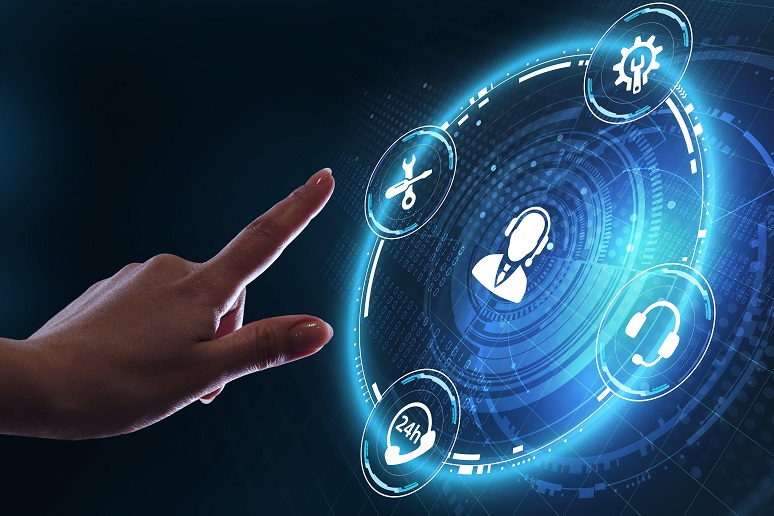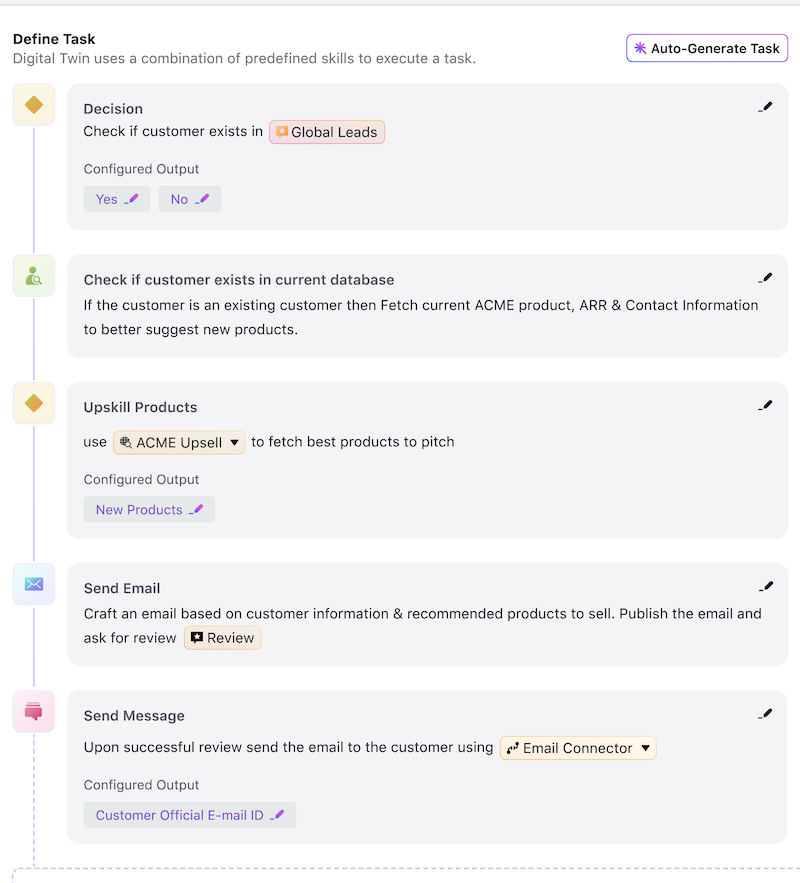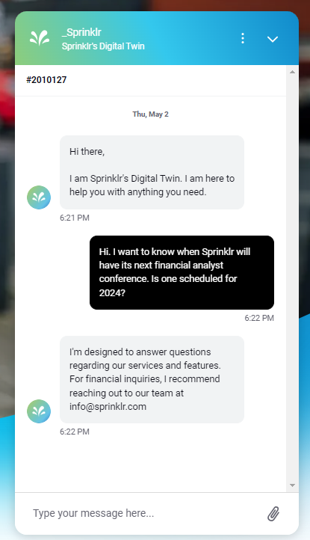Sprinklr Digital Twin, a solution in development described as an “AI version of your brand, your teams, and your employees,” was announced by the SaaS company today, The announcement was made in advance of CXUnifiers, Sprinklr’s “flagship event” for customers and prospects being held this week in New Orleans.
What is a Digital Twin?
I have seen the term “digital twin” bandied about in the technology press for the past couple of years, but having the phrase applied in the CX market is new to me. If the term is completely foreign to you, think of a digital twin as a virtual replica of a physical object, person, or process that can be used to simulate the original’s behavior to better understand how it works in real life. Digital twins are linked to real data sources from the environment, which means that the twin updates in real time as the data does, to better reflect the original version.
To date, most digital twin use cases I have read about centered on improving business functions through simulation, integration, testing, monitoring, or maintenance. Sprinklr is intentionally using the term differently.
What is a Sprinklr Digital Twin?
A Sprinklr Digital Twin interacts directly with customers, employees, and other business connections, as well as with data, applications, and systems in a business. That might be a marketing digital twin responding to a customer pricing question or a list of partners being invited to an upcoming event. These communications could occur at any time during the customer or partner’s journey with a company. CEO and founder Ragy Thomas provided the following context when he pre-briefed me on the announcement. Since the early uses of artificial intelligence, “We've tried agent, virtual assistant, digital assistant, as well as Amy, Sam and Clippy, etc., to describe entities meant to support employees or customers,” Thomas said.
But think about how a chatbot works, Thomas went on. A customer or consumer experiences cognitive dissonance when they are meant to feel as if they’re interacting with a brand representative but are clearly dealing with a bot – say, they wanted to interact with someone at Microsoft but ended up talking with Clippy instead. Thomas believes the chatbot experience creates consumer fear that the interaction will devolve into a dead end, with the consumer having to begin the problem-resolution process anew with a live agent. All of which makes consumers less likely to use bots in the future.
Using Digital Twin is Sprinklr’s way of differentiating the user experience it’s offering from a general copilot or AI assistant. A Sprinklr Digital Twin will function as a virtual assistant for a specific entity. Each digital twin will be assigned to, and act on behalf of, one of three levels within the company: the company brand, a team within that company, or an individual within the company.
Who Would Benefit from a Sprinklr Digital Twin?
Sprinklr’s flagship solution is called Unified Customer Experience Management (Unified-CXM). It offers applications for social media management, service (including contact center) and marketing departments as well as common analytics and AI to support these applications. Thomas wants businesses to think of Unified-CXM as a unified front office platform.
Sprinklr Digital Twins will enable users of one or more Sprinklr applications to build autonomous and intelligent AI that can mirror and enhance the capabilities of customer-facing teams. Each entity will also be able to create multiple personas that can be used depending on the communicator. For example, a sales executive might create different personas for customers, subordinates, prospects, etc. I am sure Thomas envisions a world where every user of a Sprinklr application would be a Sprinklr Digital Twin user.
What Can a Sprinklr Digital Twin Do and How?
Thomas is positioning Sprinklr Digital Twin as a new AI technology that goes far beyond traditional conversational AI chatbots. A Sprinklr Digital Twin will not just manage interactions; it will be able to make decisions, plan actions, design workflows, and execute tasks at scale with speed and efficiency on behalf of an employee, department, or brand.
Note that Sprinklr Digital Twins will have the same access to systems and information that the actual entity does. For example, a sales executive’s Sprinklr Digital Twin would be able to send communications to all of the accounts of his salespeople while salespeople would be able to send communications to their accounts. Sprinklr proprietary guardrails would also be applied to content created by Sprinklr Digital Twins.
Sprinklr Digital Twins will be powered by Sprinklr AI+, the Gen AI-enhanced version of the company’s AI platform capabilities. An entity’s Sprinklr Digital Twin will have access to the same data and the same systems as the person or department. “When the inquiry does not require human assistance and is completed by the digital twin, it uses the same workflow, with the same context, that the real entity would have. That's what truly makes it a digital twin,” Thomas explained.
“The magic is, it also knows how to fall back on the real entity - the real human being, the real team,” highlighted Thomas.
As a Unified-CXM service, Sprinklr Digital Twins will be able to take advantage of all of the capabilities of the platform, e.g., the concepts of queues and workflows, integrations with a lengthy list of social media platforms, etc. All of the data integrations available in Sprinklr today, e.g., Salesforce, will also be available to Sprinklr Digital Twins.
The graphic below outlines a typical set of tasks, and the kinds of resources, a Sprinklr Digital Twin could be built to do and use. Note that in one of the steps shown, human review is included before an email is sent to a customer.
Live or Virtual?
If a personal Sprinklr Digital Twin asks for a meeting or sends an invoice to a client, is it important for the recipient to know it is not from the actual person? Sometimes yes and sometimes no. Thomas is suggesting a symbol to communicate when a Sprinklr Digital Twin is responding to an interaction versus the physical person or entity.
Just as @mcgeesmith became my Twitter identity, or [email protected] one of my email addresses, _mcgeesmith would represent my Sprinklr Digital Twin responding on my behalf. Underscore would denote a virtual presence, in this case Virtual Sheila, had created a communication. When a customer, partner or prospect interacted with the company website, the use of underscore with the company name would mean that the AI-driven bot was acting on behalf of the company.
A Work in Progress
What Thomas described to me, and what will be presented at CXUnifiers this week, is an early version of Sprinklr’s Digital Twin vision. Thomas said that the Sprinklr website is already using what I would call the “alpha test” version of the software. As seen in the accompanying graphic, the _Sprinklr Digital Twin is live on the Sprinklr website.
Thomas has long described Sprinklr’s product development process as one that is based on working with definitional customers. These are early users that provide critical collaboration and feedback as the compnay continues to innovate and develop AI systems like Sprinklr Digital Twin.
As was true of its CCaaS application in 2022, Sprinklr Digital Twin is being created with the input of around five customers. From there, Sprinklr will open up the solution to another dozen or so customers and the final stage will be general availability. Thomas reports he expects to bring Sprinklr Digital Twins to general availability by 2025, possibly in the fourth quarter of 2024.
I tried out the Sprinklr Digital Twin available on the company’s website. Like any good analyst, I asked _Sprinklr a question meant to test the breadth of the system’s capability (see screenshot). At least as of May 2nd, _Sprinklr did not have access to information on when financial analyst meetings are planned. However, instead of just saying it didn’t know, as many chatbots might, it did offer me an alternative way to get an answer. I’m hoping if I were to ask again, _Sprinklr would have been given access to investor relations information.
The most often talked about use cases for GenAI in contact centers in 2023 were agent assist and automatic summarization. In a fireside chat recently, I said I was looking forward to the exciting new uses cases we might see in 2024. I am excited to see how Sprinklr Digital Twin technology evolves and what customer collaborators deploy it. It is a thought leadership play, not a “me too.”











